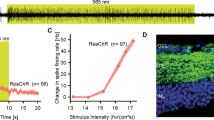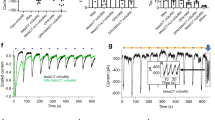Abstract
The expression of light-sensitive microbial opsins is a promising mutation-independent approach to restore vision in retinal degenerative diseases. Using viral vectors, optogenetic tools can be genetically expressed in various subpopulations of retinal neurons. The choice of cell type depends on the availability of surviving retinal cells. If cones are still alive but they lack outer segments, they can be targeted with optogenetic inhibitors, such as halorhodopsin. Alternatively, it is possible to bypass the photoreceptors and to target bipolar cells. In late-stage degeneration, when bipolar cells degenerate, “artificial photoreceptors” can be made from retinal ganglion cells, but with this approach, upstream retinal processing cannot be utilized. However, when ganglion cells are stimulated directly, higher brain regions might be able to compensate for some loss of retinal processing, which is indicated by clinical studies with epiretinal implants, where patients can perform simple visual tasks. Finally, optogenetics in combination with neuroprotective approaches could serve as a valuable strategy to restore the function of remaining cells, as well as to rescue retinal neurons from progressive degeneration.
Access provided by CONRICYT-eBooks. Download conference paper PDF
Similar content being viewed by others
Keywords
Optogenetics is a technique that allows for the optical control of neural activity (Boyden et al. 2005; Deisseroth et al. 2006; Häusser 2014) by using light-sensitive ion channels or pumps derived from algae or bacteria (e.g., channelrhodopsin or halorhodopsin) (Nagel et al. 2003; Oesterhelt and Stoeckenius 1971; Sugiyama and Mukohata 1984), as well as other optogenetic tools, such as vertebrate opsins (Herlitze and Landmesser 2007). In a degenerated blind retina, the specific expression of optogenetic tools enables to convert specific retinal cells types into “artificial photoreceptors ” (Sahel and Roska 2013).
Depending on the degenerative state of the retina, different optogenetic strategies can be used (Fig. 9.1). Targeting of retinal photoreceptors could be an option for RP patients with remaining cone cell bodies lacking their light-sensitive outer segments. Anatomical studies, using postmortem retinal tissue (Lin et al. 2009) or in vivo imaging (optical coherence tomography) from RP patients (Jacobson et al. 2013), have shown that some patients with late-stage RP had residual cone cell bodies. These observations suggest that there are candidates who could be eligible for photoreceptor-based strategies . In the mouse model, the reactivation of nonfunctional but surviving “dormant” cones, using the light-sensitive chloride pump halorhodopsin, has been shown by Botond Roska’s group (Busskamp et al. 2010). Halorhodopsin was able to substitute for the impaired phototransduction cascade in treated blind mice. These reactivated cones could drive retinal circuit functions, including lateral inhibition and directional selectivity, and they mediated cortical processing as well as visually guided behavior. Moreover, human retinal explants were used to reactivate light-insensitive photoreceptors with halorhodopsin, demonstrating the functionality of the microbial opsin in the human retina.
Schematic diagram of a healthy retina compared to retinae with progressive degeneration and circuit remodeling. The choice of the therapeutic strategy is determined by the availability of persisting cell types, ranging from targeting “dormant” cones (1), bipolar cells (2), to retinal ganglion cells (3). Horizontal cells and amacrine cells are shown in dark purple and yellow, respectively. INL inner nuclear layer
However, it is unknown how long synaptic connection from photoreceptors to bipolar cells will remain under degenerative conditions. Therefore, cell type-specific targeting of optogenetic tools to retinal bipolar cells would be another attractive option. In a pioneering study, Lagali et al. used electroporation to express channelrhodopsin (ChR2) under control of the ON bipolar cell promoter in ON bipolar cells of blind mice (rd1), leading to the recovery of visually evoked potentials in the cortex and visually guided behavior (Lagali et al. 2008). Electroporation, however, had to be replaced by viral gene delivery suitable for potential clinical applications. Meanwhile, AAV-based vectors with improved retinal diffusion properties have been developed (Dalkara et al. 2013), and it has been shown that these engineered AAVs can efficiently deliver ChR2 variants to ON bipolar cells (Cronin et al. 2014; Macé et al. 2015) of blind mice. Importantly, ChR2 targeted to ON bipolar cells restored both ON and OFF component of the visual responses, which is mediated by inner retinal processing. The restoration of the ON/OFF pathway was also observed in the retina and in the visual cortex. In addition, light-induced behavior was observed in these treated blind mice (Cehajic-Kapetanovic et al. 2015; Gaub et al. 2014, 2015; Macé et al. 2015; van Wyk et al. 2015), but targeting of bipolar cells has not yet been accomplished in non-human primates.
Finally, optogenetic targeting of ganglion cells could be a therapeutic strategy for patients with late-stage degeneration and advanced remodeling of inner retinal circuits (Jacobson et al. 2013; Jones et al. 2016). Bi and Pan were the first to show that light sensitivity can be restored through expression of ChR2 in retinal ganglion cells after complete photoreceptor degeneration (Bi et al. 2006), which was followed by other studies (Caporale et al. 2011; Greenberg et al. 2011; Ivanova and Pan 2009; Lin et al. 2008; Sengupta et al. 2016; Tomita et al. 2010; Tomita et al. 2007; Wu et al. 2013; Zhang et al. 2009). A disadvantage of this approach is that neural circuits upstream of ganglion cells cannot be utilized. On the other hand, clinical studies using direct electrical stimulation of ganglion cells with epiretinal implants have shown that patients are able to perform visual tasks, such as object localization or motion discrimination (Humayun et al. 2012; Shepherd et al. 2013). This indicates that the plasticity of higher brain regions can compensate for some loss of retinal image processing and that the human cortex has the capability to adapt to a visual code that is different from the natural activity pattern conveyed by a healthy retina.
In summary, optogenetics enables to confer light sensitivity to distinct retinal cell types, thus offering new therapeutic approaches to restore vision in a wide range of retinal degenerative diseases. In a future perspective, combined approaches of optogenetics with neuroprotection could be a therapeutic option, not only to restore the function of remaining cells but also to rescue retinal structures from progressive degeneration (Sahel and Roska 2013). Although the therapeutic benefits of optogenetic approaches remain to be determined, first steps toward clinical application (ClinicalTrials.gov Identifiers: NCT02556736, NCT03326336) have been taken.
References
Bi A, Cui J, Ma YP et al (2006) Ectopic expression of a microbial-type rhodopsin restores visual responses in mice with photoreceptor degeneration. Neuron 50:23–33
Boyden ES, Zhang F, Bamberg E et al (2005) Millisecond-timescale, genetically targeted optical control of neural activity. Nat Neurosci 8:1263–1268
Busskamp V, Duebel J, Balya D et al (2010) Genetic reactivation of cone photoreceptors restores visual responses in retinitis pigmentosa. Science 329:413–417
Caporale N, Kolstad KD, Lee T et al (2011) LiGluR restores visual responses in rodent models of inherited blindness. Mol Ther 19:1212–1219. article
Cehajic-Kapetanovic J, Eleftheriou C, Allen AEE et al (2015) Restoration of vision with ectopic expression of human rod opsin. Curr Biol 25:2111–2122. article
Cronin T, Vandenberghe LHH, Hantz P et al (2014) Efficient transduction and optogenetic stimulation of retinal bipolar cells by a synthetic adeno-associated virus capsid and promoter. EMBO Mol Med 6:1175–1190. article
Dalkara D, Byrne LC, Klimczak RR et al (2013) In vivo-directed evolution of a new adeno-associated virus for therapeutic outer retinal gene delivery from the vitreous. Sci Transl Med 5:189ra76
Deisseroth K, Feng G, Majewska AK et al (2006) Next-generation optical technologies for illuminating genetically targeted brain circuits. J Neurosci 26:10380–10386
Gaub BMM, Berry MHH, Holt AEE et al (2014) Restoration of visual function by expression of a light-gated mammalian ion channel in retinal ganglion cells or ON-bipolar cells. Proc Natl Acad Sci U S A 111:E5574–E5583. article
Gaub BM, Berry MH, Holt AE et al (2015) Optogenetic vision restoration using rhodopsin for enhanced sensitivity. Mol Ther 23(10):1562–1571. article
Greenberg KP, Pham A, Werblin FS (2011) Differential targeting of optical neuromodulators to ganglion cell soma and dendrites allows dynamic control of center-surround antagonism. Neuron 69:713–720. article
Häusser M (2014) Optogenetics: the age of light. Nat Methods 11:1012–1014
Herlitze S, Landmesser LT (2007) New optical tools for controlling neuronal activity. Curr Opin Neurobiol 16(1):87–94
Humayun MS, Dorn JD, da Cruz L et al (2012) Interim results from the international trial of second Sight’s visual prosthesis. Ophthalmology 119:779–788
Ivanova E, Pan Z-H (2009) Evaluation of the adeno-associated virus mediated long-term expression of channelrhodopsin-2 in the mouse retina. Mol Vis 15:1680–1689
Jacobson SG, Sumaroka A, Luo X et al (2013) Retinal optogenetic therapies: clinical criteria for candidacy. Clin Genet 84:175–182. article
Jones BW, Pfeiffer RL, Ferrell WD et al (2016) Retinal remodeling in human retinitis pigmentosa. Exp Eye Res 150:149–165
Lagali PS, Balya D, Awatramani GB et al (2008) Light-activated channels targeted to ON bipolar cells restore visual function in retinal degeneration. Nat Neurosci 11:667–675. article
Lin B, Koizumi A, Tanaka N et al (2008) Restoration of visual function in retinal degeneration mice by ectopic expression of melanopsin. Proc Natl Acad Sci U S A 105:16009–16014. article
Lin B, Masland RH, Strettoi E (2009) Remodeling of cone photoreceptor cells after rod degeneration in rd mice. Exp Eye Res 88:589–599
Macé E, Caplette R, Marre O et al (2015) Targeting channelrhodopsin-2 to ON-bipolar cells with vitreally administered AAV restores ON and OFF visual responses in blind mice. Mol Ther 23:7–16. article
Nagel G, Szellas T, Huhn W et al (2003) Channelrhodopsin-2, a directly light-gated cation-selective membrane channel. Proc Natl Acad Sci U S A 100:13940–13945. article
Oesterhelt D, Stoeckenius W (1971) Rhodopsin-like protein from the purple membrane of Halobacterium halobium. Nat New Biol 233:149–152
Sahel J-AA, Roska B (2013) Gene therapy for blindness. Annu Rev Neurosci 36:467–488
Sengupta A, Chaffiol A, Macé E et al (2016) Red-shifted channelrhodopsin stimulation restores light responses in blind mice, macaque retina, and human retina. EMBO Mol Med 8:1248–1264
Shepherd RK, Shivdasani MN, Nayagam DAX et al (2013) Visual prostheses for the blind. Trends Biotechnol 31:562–571. article
Sugiyama Y, Mukohata Y (1984) Isolation and characterization of halorhodopsin from Halobacterium halobium. J Biochem 96:413–420
Tomita H, Sugano E, Yawo H et al (2007) Restoration of visual response in aged dystrophic RCS rats using AAV-mediated channelopsin-2 gene transfer. Invest Ophthalmol Vis Sci 48:3821–3826. article
Tomita H, Sugano E, Isago H et al (2010) Channelrhodopsin-2 gene transduced into retinal ganglion cells restores functional vision in genetically blind rats. Exp Eye Res 90:429–436
Wu C, Ivanova E, Zhang Y et al (2013) rAAV-mediated subcellular targeting of optogenetic tools in retinal ganglion cells in vivo. PLoS One 8:e66332. article
van Wyk M, Pielecka-Fortuna J, Löwel S et al (2015) Restoring the ON switch in blind retinas: opto-mGluR6, a next-generation, cell-tailored optogenetic tool. PLoS Biol 13:e1002143. article
Zhang Y, Ivanova E, Bi A et al (2009) Ectopic expression of multiple microbial rhodopsins restores ON and OFF light responses in retinas with photoreceptor degeneration. J Neurosci 29:9186–9196
Author information
Authors and Affiliations
Corresponding author
Editor information
Editors and Affiliations
Rights and permissions
Copyright information
© 2018 Springer International Publishing AG, part of Springer Nature
About this paper
Cite this paper
Chaffiol, A., Duebel, J. (2018). Mini-Review: Cell Type-Specific Optogenetic Vision Restoration Approaches. In: Ash, J., Anderson, R., LaVail, M., Bowes Rickman, C., Hollyfield, J., Grimm, C. (eds) Retinal Degenerative Diseases. Advances in Experimental Medicine and Biology, vol 1074. Springer, Cham. https://doi.org/10.1007/978-3-319-75402-4_9
Download citation
DOI: https://doi.org/10.1007/978-3-319-75402-4_9
Published:
Publisher Name: Springer, Cham
Print ISBN: 978-3-319-75401-7
Online ISBN: 978-3-319-75402-4
eBook Packages: Biomedical and Life SciencesBiomedical and Life Sciences (R0)





